Veranda Tales-Sifting through

Storytelling has been an integral part of my life since childhood. I grew up listening to stories during the hot summer evenings and nights with my cousins. Mothers and grandmothers would gather all of us children for story time. It was usually pitch dark except for a very faint light coming from the flickering candle. Power cuts were as frequent as the hot and humid summer days. We all spread out on a cool concrete floor or bamboo mats on the veranda intently listening to fascinating stories about kings, queens, princes, princesses, and peasants alike. Stories about love, life, families, and people entertained and taught us life skills. These stories transported us to distant worlds, strange yet familiar. Often the same story told by two people sounded different as storytellers added new twists and turns adding their personal style and flair to the stories.
Storytelling wasn’t limited to summer evenings and bedtime. I was surrounded by adults who didn’t pass up an opportunity to share their wisdom using the art of storytelling. These rich vibrant oral traditions include songs, poems, stories, and సామెతలు (Sametalu are proverbs in Telugu). Men and women sing songs as they work in the fields, grinding grains and spices and doing other daily chores at their homes. Stories are often used to teach important life lessons, interpersonal skills, and survival skills. These stories and the time spent listening to them made our lives richer leaving an impression on me. This series is all about reliving those memories as I share these stories.
విన్నవి అన్ని విశ్వాశించవద్దు, విశ్వాసించినవన్నీ వెలిబుచ్చవద్దు (Vinnavi anni viswasichavaddu, viswasimchinavanni velibuchchavaddu)
Just a few decades ago, the web was short for cobwebs, which we could see, touch, and were routinely destroyed during house cleaning. Four decades ago, a mouse was just a pesky little creature that destroyed crops and grains. The words wired, wireless, and Bluetooth mice weren't in our vocabulary. Receiving a fountain pen from a relative for securing good grades was a thing of pride. People wrote letters using their prized fountain pens and fine ink. Paper, ink bottles, spare fountain pen పాళీలు (paleelu are nibs in Telugu) were the must have items in any household and for students of all ages. People worked on improving their handwriting and took pride in their cursive writing skills.
తాతయ్య (Tatayya is grandfather in Telugu) employed several గుమస్తాలు (gumastalu are clerks in Telugu) to write legal briefs. They would sit at their old fashioned legal desks writing, revising, rewriting, and correcting legal briefs all day long. I would see them hard at work in a room on the terrace which we called the గుమస్తా ( gumasta) గది (gadi is room in Telugu) while I ran around on the terrace with my cousins. I was fascinated by their beautiful handwriting and admired the beauty of longhand scripts. I was allowed to take a peek at the legal briefs on occasion. I played messenger girl carrying the legal briefs that were ready for తాతయ్య (Tatayya)’s review to wherever he was in the living quarters and taking them back to the గుమస్తా గది (gumasta gadi) after he reviewed them.
People wrote letters to their family and friends to stay connected. Emergency communication which was usually bad news was delivered via telegrams. We received happy and sad tidings from family and friends in letters. Marriage invitations were printed on cards using red ink with embossed lettering and invitations to funeral ceremonies were printed using black ink. తాతయ్య (Tatayya) saved every letter and card he received. After reading letters and cards, తాతయ్య (Tatayya) would ask one of his grandchildren to save them for future reference. They were all archived on a very sturdy iron wire hanging on a nail in the wall in a corner in the dining room at my grandparents’ place. The top of the “J” shaped wire was straight except for a small loop to hook it to the mail and the bottom was curved so the letters and cards wouldn’t fall out.
Death announcements were torn a little in the left or right corner before putting them on the wire to ward off the ill effects of the bad news. New letters and cards were added to the top of the wire and older ones were taken from the bottom to be discarded periodically. Removing items for discarding followed the first in and first out (FIFO) algorithm for software. The wire would sag under the weight of the letters and cards that grew from several inches to a feet in length.
These archived letters served as a calendar. తాతయ్య (Tatayya) would ask me to get an archived card when he was ready to head out to an event to double check the time and the venue. After confirming the details, the card would be put back on the wire in the same place where it was taken from to preserve the order in which it was received. The wire laden with letters and cards was very heavy for my little hands. I would bring it down from the nail it was hanging from to search for the card. Once I found the card, I would carefully remove letters and cards that were on top of it and set them aside so I could place the card taken out for reference and put it back on the wire in its original location. I would help discard the old cards periodically. This process was easier as it required taking the letters and cards from the bottom.
News was delivered to our door steps in a printed form like it does today, even though print form is becoming severely endangered and could disappear all together. I grew up reading The Hindu, a English newspaper, and ఈనాడు (Eenadu), a Telugu newspaper everyday, weekly magazines - ఆంధ్రజ్యోతి (Andhra Jyothi), ఆంధ్రప్రభ (Andhra Prabha), ఆంధ్ర పత్రిక (Andhra Patrika), and monthlies - Chatura and Vipula. I have fond memories of waiting all week or month long to get my hands on a new issue. On my recent visit to Chicago, I found empty newspaper vending stands on a sidewalk. It was a classic wrought iron newspaper vending box, sitting empty. I felt a pang of nostalgic sadness followed by the realization that it was a symbol of a bygone era as most people, myself included, get our news from online sources.

My other source of news and current events was radio when I was growing up and continues to be one to this day. I am thankful that my phone allows me to catch up on world events, providing me with an ample supply of online news publications, radio, audio, and video blogs. It helps me stay connected with my family and friends from anywhere in the world, even when I am flying 36000 miles above the Earth. Since the advent of the internet, information travels almost at the speed of light as an event from a far corner of the world is made available to us on our phones and tablets almost instantaneously. We no longer have to carry picnic baskets to watch wars unfold like people in America did during the Civil War. I find it strange and morose to watch people killing each other while eating a sandwich. But then we have the legacy of people watching and cheering as slaves fight to the death at Roman Colosseums.
It is an age-old problem that news could be inaccurate or reported with a bias. This is true with any source of information such as a radio or word of mouth. When a story gets repeated, each retelling alters it just a bit and by the time the story gets back to its origin it would sound like a new story. Stories abound about Yeti and numerous articles followed these accounts, trying to prove the existence of this ape-like creature.
విన్నవి అన్ని విశ్వాశించవద్దు, విశ్వాసించినవన్నీ వెలిబుచ్చవద్దు (Vinnavi anni viswasichavaddu, viswasimchinavanni velibuchchavaddu) means, “Don't believe everything you hear and don’t share everything you believe in”. This first part of this sameta cautions us against believing everything we hear blindly. The second part of this sameta urges us to refrain from expressing everything we believe in. As an example, I might find the existence of Yeti believable and if I were to share my belief, I could be laughed at.
Thanks to technology and the world wide web, our news is richer with pictures, audio and video clips. It can be shared with the world with mere click of a button. The news can be forwarded almost immediately with a click or swipe on social media platforms. As a result the information flow is prolific and it is often hard to keep up with the happenings around the world that show up on our social media platform feeds. It is like trying to drink from a firehose and still run the risk of dehydration. It is hard to retain the flood of information in our brains.
Social media and news consolidating sites curate and tailor the feed for us. I happened to click on news about Amitabh Bachchan’s bout with Covid and my feed was full of all the happenings in the Bachchan family until I got tired of it and took measures to block it. Curating and tailoring of news feeds creates echo chambers and it is a challenge to avoid getting stuck in one. We run the risk of developing one sided views which will prevent us from expanding our knowledge. The rush to publish a story to get the most clicks leads to publishing it without verifying whether it is true or false. Readers are equally in a rush to share stories in their feed with others without verifying if it is true or not. It is very difficult to resist sharing information as it costs absolutely nothing. Adding to the challenges of keeping up with the flood of information, we now have an additional challenge of figuring out if it is real or fake. We are burdened with the task of verifying if a video clip about some event is real, misattributed and/or doctored.
We are not sure if a story we read in the news or on a social media platform feed is real or fake. We often don’t know if we can believe what we read and heard is real. This reminds me of another Telugu sameta, సత్యం చెప్పుల్లో కాళ్ళు పెడుతూంటే, అసత్యం ప్రపంచమంతా చుట్టి వస్తుంది (satyam cheppullo kaallu peduthunte, asatyam prapanchamanta chutti vastundi), which means “While truth is still getting its shoes on, lie circles the world and comes back”. Fake news travels faster than the real one.
The challenge of sifting through real and false information is as old as human speech and cave art. The విన్నవి అన్ని విశ్వాశించవద్దు, విశ్వాసించినవన్నీ వెలిబుచ్చవద్దు (Vinnavi anni viswasichavaddu, viswasimchinavanni velibuchchavaddu) sameta aptly conveys this sentiment and challenge. When this sameta originated, our information and its sources were limited. We could take our time to process the information. We now have numerous sources which are often contradictory. It is a true challenge to keep up with the flow of information and assess its validity. This sameta and the age old wisdom it conveys is more important than ever today. It cautions me to verify the sources for all the information that reaches my eyes and ears. It is an age old wisdom that continues to guide us all.
